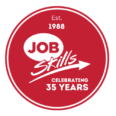
As social media platforms improve their accessibility, job seekers with disabilities have greater access to employment opportunities through these networks. Social media is no longer about maintaining personal connections. Seventy percent of employers use social media to screen candidates during the hiring process. LinkedIn remains the primary social media platform for job seekers. However, each social network can help make you a desirable candidate for a recruiter or hiring manager. Actively developing your social media presence and showcasing your experience is a great way to build name recognition and compensate for employment gaps or lack of employment experience.
Think of these ten tips to use social media when looking for a new job!
- Complete/update your profiles– Often, recruiters and employers use social media to find applicants before a job has been posted. Completing and updating each section of your profile – including employment history, education, and skills – demonstrates that you’re serious about your job search.
- Join relevant conversations/groups– Across social media platforms, conversations are happening that connect to your career interest area(s). Joining and participating in relevant groups on LinkedIn and Facebook or participating in industry-specific Twitter chats allows you to expand your networks and follow interesting discussions, demonstrating your passion and expertise in a specific profession or field of study. There are also numerous disability-specific groups across social media platforms such as onwin.ca that provide excellent resources.
- Refine your privacy settings– “De-clutter” your social media, including paring down connections and removing questionable content. Make sure your social network pages are set to “private.” Certain aspects of your profile may still be viewable, such as contact and basic info, work experience, and education. Use caution when posting content – ask yourself, “Would there be a concern if my employer saw this?”
- Inform connections of your search – Directly informing your connections you’re searching for a job is a key way to learn about opportunities. Ensure your resume is uploaded online for sharing. LinkedIn and Facebook allow you to house your resume within your profile or send a link to your website where you should have a digital copy.
- Stay current – Staying up-to-date on current events that support diversity and disability inclusion, including relevant awareness campaigns and commemorative months/days, can lead you to the right employer. Consider following relevant hashtags on Twitter and Facebook that may lead to potential connections you can reach out to.
- Follow and engage with relevant employers – Use your social media presence to engage with potential employers – post positive comments and share their blog posts and other activities. Look out for media messaging that focuses on inclusive employer initiatives. By following these employer profiles, you have background and context for industry-wide priorities and can share insights and perspectives on your platforms.
- Maintain consistency – Be sure not to neglect or overlook one social media platform over another. Use consistent information across your social media profiles and resume, including your employment history, skills, education, and contact information. This eliminates confusion for potential employers.
- Add your profiles to your resume/website – An employer should easily access your online profiles. Include email addresses on your job search materials (resume, website, etc.), and list your professional social media handles. This demonstrates your active engagement in your industry of interest.
- Perfect your profile photo– Pictures speak volumes, and an appropriate headshot goes a long way in demonstrating your professionalism and seriousness about your job search (no photos on the beach!). Your profile photo doesn’t need to be business formal. However, it is essential to ensure that it is high-quality (not grainy). Business casual is recommended dress.
- Don’t erase your profiles – Fears of a potential employer finding something harmful or embarrassing sometimes causes job seekers to erase their social media profiles. Having a lack of social media presence often serves as a red flag for employers. Research shows that 47% of employers wouldn’t call a person for an interview if they couldn’t find them online – it lacks professionalism and insinuates that there’s something to hide.
Job Skills menu of online workshops and resource links will assist you in your job search. Register for ‘Cover Letters that Open the Door’ on Jun 10th, 10:00 am – 11:00 am for more tips and assistance.
If you haven’t connected with an Employment Consultant at Job Skills, NOW is the time to get that one-on-one support you need as you move through the new way of working. Call Job Skills toll-free at 1-866-592-6278 to connect to one of Job Skill’s experts.

